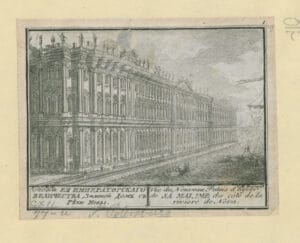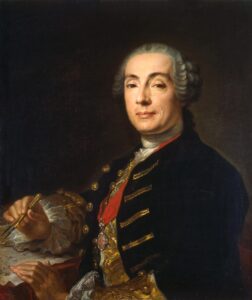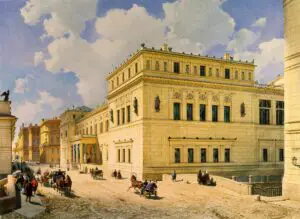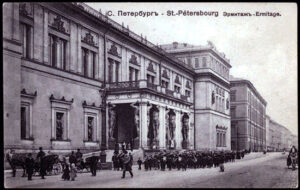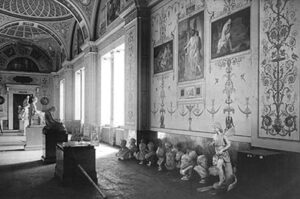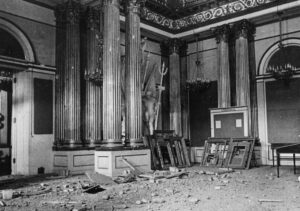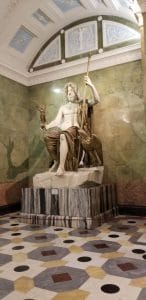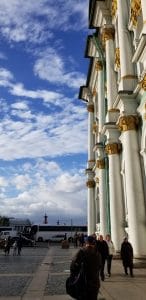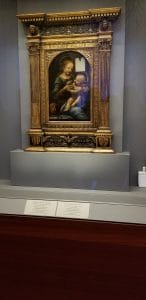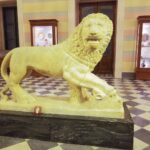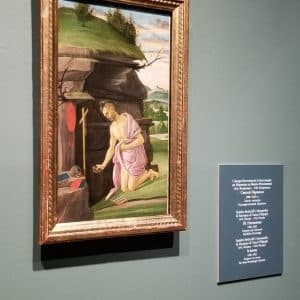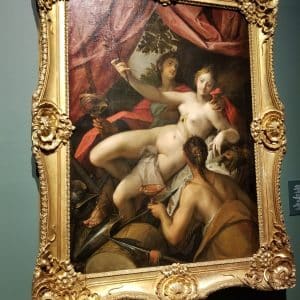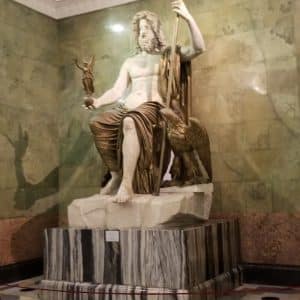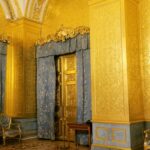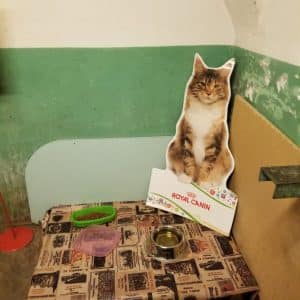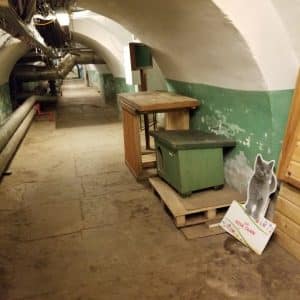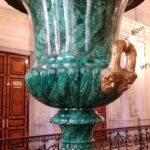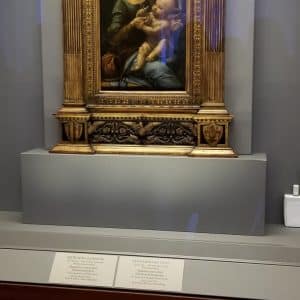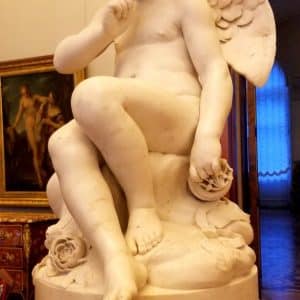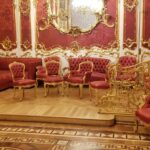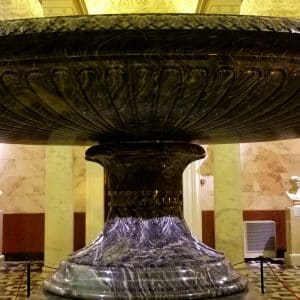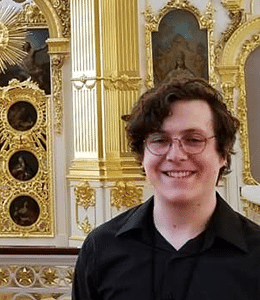The following provides a short history of The Winter Palace building and The State Hermitage Museum as well as details the museum’s current programs and world-wide activities today. It also provides reviews of self exploration and guided tours of the Hermitage.
Hermitage tours are included with most St. Petersburg SRAS Programs and Moscow SRAS programs.
The Storied History of the Hermitage
By Elias Law and Josh Wilson
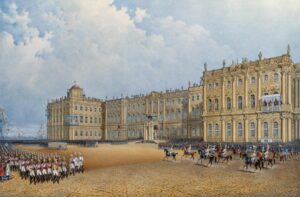
The Hermitage is a travel destination, artwork, and history unto itself. One could spend days in the labyrinthine rooms and anterooms and never see all the art on display – and this is not to mention that in its vaults rests about 20 times more art than even these rooms can hold.
One of the city’s best-recognized landmarks, the museum lies directly in the city center, with the city center’s radial roads pointing towards it; even someone lost in St. Petersburg has a good chance of finding themselves at the doorstep of this world-renowned art collection.
The Hermitage is a vast complex of buildings. Its main part is an interconnected mass composed of the Winter Palace, Large Hermitage, Small Hermitage, New Hermitage, and the Hermitage Theater. Across Palace Square, the East Wing of the General Staff Building, and, across the river, the Menshikov Palace have been added to the museum’s facilities in recent years. Meanwhile, on the outskirts of the city, a new, state-of-the-art Hermitage Storage and Restoration Centre has been built. Further afield, the Hermitage now has auxiliary spaces across Russia and even abroad.
The Beginnings of the Hermitage Museum Complex
The Hermitage complex as a whole started with the Winter Palace in the 1700s. Empress Elizabeth Petrovna and the Italian architect Bartolommeo Francesco Rastrelli constructed abaroque-style palace to serve as a winter residence for the royal family. It took eight years to build and was said to have been so rich and ornate that, together with the Empress’ other luxurious and fickle tastes, it nearly bankrupted the country. The Empress died before construction ended, a task that then fell to Catherine the Great who chose a more neo-classical but no less ambitious style in its continued expansion and construction.
Completed in 1762, Winter Palace became the royal residence that year when Catherine the Great lead a successful coup against her husband, Peter III. Soon afterward she began collecting art with a ferociousness that only a ruler of an immense country could. In one transaction with British Prime Minister Sir Robert Walpole, she exchanged a single portrait of herself for fifteen paintings by renowned Dutch artist Anthony Van Dyke. In other transactions, she purchased vast collections in their entirety from European aristocrats.
During Catherine’s reign, the Large and Small Hermitages were added as well as the Theater. The theater was built to help sate Catherine’s great passion for opera. The Small Hermitage originally held royal stables in basement and an equestrian training hall on the first floor. The upper levels are connected to the palace via skyway and include a grand hanging garden and two large pavilions.
The Hermitage Museum today often dates its beginning to 1764, when Catherine bought a large collection of 225 paintings from a Berlin merchant named Gotzkowsky. This was followed by the acquisition of the 600-painting Bruhl collection in 1769. Construction of the Large Hermitage began in 1771 specifically to house this extensive and growing royal art collection.
The Hermitage Museum Opens
However, that royal collection would remain for the private viewing of ruling classes until 1852 when the Imperial Museum was opened in the New Hermitage after Nicholas I ordered that building rebuilt and expanded, and that a new public entrance be installed. This was the first structure built in Russia as a public museum. Nicholas I decided to make at least a part of his collection public after touring several well-established public museums in Western Europe.
The collections continued to expand at a phenomenal rate, including purchases of art by Raphael and da Vinci in the later 1800s and early 1900s. At the beginning of WWI, most of its art was transferred to Moscow for safekeeping and much of the Winter Palace became a military hospital.
The Hermitage and the Revolution
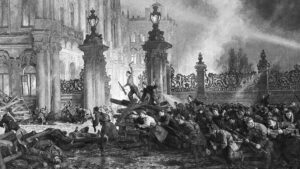
After the Communists came to power, nearly the entire complex was given over to the public museum. This decision was made not only in the interests of public enlightenment and education, but also to allow the bulging collection to spread to more display space, and also as propaganda: to allow the public to see the sprawling luxury built with public funds to serve one family.
The Provisional Government, in fact, nationalized all palaces and the art held in them, establishing the Committee on Art and History, housed in the palace, to begin a massive inventory. This inventory would not be completed, however, as the staff were soon barricading the museum against possible looting and rioting in the Bolshevik Revolution. Thankfully, the famous shelling of the Winter Palace by the cruiser Aurora did not affect the New Hermitage or its art, much of which was still in Moscow anyway. To their credit, the Bolsheviks dispatched an armed detail to guard the building and its art soon after taking control.
The Winter Palace also became the headquarters for the new Commissariat for Education, hosting galleries (the art returned from Moscow in 1920), films, lectures, concerts, and a Museum of the Revolution. Several rooms were left as a memorial to remind people how well the Tsars lived while their people were starving. Many still remark that the entire Hermitage bears excellent witness to the phenomenal social gap that helped spark revolution in Russia.
1920-1930 saw a further swelling of the Hermitage collections from art confiscated from such famous Russian nobles as Stroganov and Sheremetyev. Other collections were taken from less famous but still important names like Count Alexey Bobrinsky, who was the former chairman of the Archaeological Society of Russia and whose “contributions” greatly bolstered the displays of ancient art. At the same time, still more works were transferred to the Hermitage from places such as the Russian Museum, which the communists wanted to be fully specialized in Russian Art. It remains so to this day.
A reversal of this inflow occurred in the early 1930s. Now facing cash shortages, the Communists appropriated some 250 pieces of art from the Hermitage’s collection to sell abroad to help fund Soviet industrialization. In addition to the auctions abroad, art was often presented to foreign dignitaries and “friends of communism” as free or nominally priced gifts. One such recipient was Andrew Mellon, the first Secretary of the US Treasury. Twenty one paintings, including four of Cathrine’s Van Dykes, would later find their way to the collections of the National Art Gallery in Washington D.C through his “purchases.” At the same time, many works were transferred to found new museums across the USSR.
However, while regrettable, this proved a small dent in the massive collections.
The Hermitage: Surviving WWII
In 1941, Hitler invaded Russia. His army had express orders to “wipe the city of St Petersburg from the face of the earth” and his army advanced on it with frightening speed. The city’s museum was saved by the actions of its residents. Then Hermitage director, Iosif Orbeli, describes the day the war started: “On the 22nd June, 1941 all the Hermitage staff were summoned to the museum. Research workers, security guards and technical personnel — everyone took part in the packing, spending no more than an hour in 24 on eating and resting. From the second day on hundreds of people who loved the Hermitage came to help us… Those people had to be ordered to eat and rest. The Hermitage was dearer to them than their own health and strength.”
The Sverdlovsk Art Gallery (now the Ekaterinburg Fine Arts Museum) was declared a branch of the Hermitage and three massive trainloads of art were prepared in record time thanks to this “self mobilization of the Leningrad intelligentsia,” as artist Ludmila Ronchevskaya would call it.
Despite their best efforts, only two of the three trains made it out of Leningrad before the Nazis surrounded the city. The third train was also kept safe, however, due to the city’s remarkably successful 847-day standoff, enduring starvation and fuel shortages. Damage to the Hermitage was minimized by the artists who took shelter there and worked to clear the rubble and remove charred flooring after each bombing. In addition to this, they also sought to record the history of the Hermitage during the war in a series of sketches and photographs, many of which the Hermitage still has in its collections. In addition, they helped clear bodies and survivors when surrounding buildings were hit, and hosted as many as 12,000 people in bomb shelters constructed in the the Hermitage’s “indestructable” basement vaults.
The Hermitage: 1945-1991
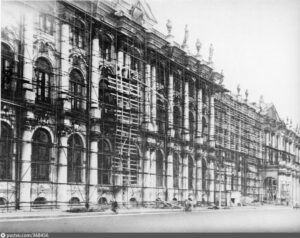
In 1945, the museum was reopened. The Soviets also began adding to the collections again through acquisitions and, perhaps most dramatically, with 74 paintings seized from Nazi Germany as war trophies.
The same artists who had preserved the Winter Palace restored many rooms in record time to house the returning paintings, which were loaded and shipped almost immediately after the peace was signed. In the years that followed, the Hermitage returned to its previous growth, acquiring new collections and even additional buildings such as the Menshikov Palace which now displays Russian cultural artifacts from the 18th century, contemporary with when the building was built.
The censorship which gripped the arts in the USSR was remarkably light on the Hermitage, which held an exceptionally high status. The collections also continued to swell. The Soviets first tried to alleviate the museum’s storage shortages in 1981 when they added the newly restored Menshikov Palace, a former noble residence, to the museum’s property.
As the government and economy crumbled, so did the funding for the museum. Priceless works of art had to be stored, guarded, and preserved on a shoestring budget. In one department, a total of 226 pieces, including icons and antiques, were lost in what was later uncovered to have been an inside heist carried out over the course of more than a decade. The fact that this could have occurred, however, is another indication of just how large the Hermitage’s collections now are.
Soon after the fall, the Hermitage formed partnerships with other major galleries across the globe and formed the “Friends of the Hermitage Foundation,” receiving substantial amounts of aid to renovate its facilities and particularly its environmental and security systems.
The Hermitage Today
The Hermitage can be seen as the heart of Russia’s cultural capital, yet it doesn’t look particularly Russian. In contrast to the Church on Spilt Blood, just a few blocks away and overflowing with unique Russian architectural elements, the Hermitage reminds one much more of the neoclassical heritage shared throughout Western Europe. The Hermitage is as much a “window on Europe” as the city itself. The building was built in part to prove that Russia could both replicate and compete with European achievements. In fact, it is the second largest art museum in the world following the Louvre. Thus, it fits perfectly into the city, its geography, history, and identity.
The Hermitage is currently ranked as the second largest art museum in the world following the Louvre, with over 3 million works of art in hundreds of rooms. Although the museum also has nearly 720,000 square feet of total exhibition space, the majority of the collection remains in storage.
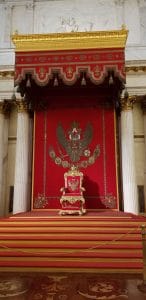
The Russian government added the East Wing of the General Staff Building, which once housed the tsar’s Ministry of Finance and Ministry of Foreign Affairs, to the museum’s property in 2014. Today it offers additional exhibition space and room for presentations and workshops.
There is also the Hermitage Volunteer Service. Created and organized by Mikhail Kozhukhovsky in 2003, the program began as a means to help the Hermitage during grand events. Now, both locals and foreigners staying in the city for a while often donate their time there translating documents, assisting in events and museum projects, or even working on projects of their own. Anyone can express interest via instructions provided on the Hermitage site. The Volunteer Service creates a sense of community – but one with an international flare.
The Hermitage Storage and Restoration Centre, a complex of nine buildings in Staraya Derevnya, just outside the city, was first opened in 2003, expanded In 2006, and is currently awaiting a third expansion. This is not just an advanced center to store and restore artworks, but also acts as an additional exposition space through a unique “open-storage” format. The space offers entry only by appointment and only with a guide, which can be reserved in several languages. More can be read about this here.
The Hermitage has also now expanded to permanent facilities for regular traveling expositions in other cities. This includes centers in nearby Vyborg and far away Vladivostok as well as Kazan. New centers are currently being developed in Omsk and Ekaterinburg. Russia’s former tsars would probably be especially proud that it now also has representations in Amsterdam and Italy, showing that Russian cultural institutions can be exported successfully to Europe.
The Hermitage had a partnership from 2001-2008 with the Guggenheim. It also received a substantial technology grant from IBM that has allowed it to set up digitized displays online. The complex also continues to host a Theater (built 1783), an orchestra (1989), and a music academy (1997), in addition to shops, cafes, and other services.
The main stage and draw of the Hermitage, however, remains the original complex of buildings. Here, there is something for every type of art or history lover, and it is recommended to do more than one trip as one could spend weeks inside the museum and still not see everything on offer.
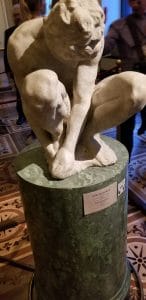
For history, the Military Gallery, for instance, lies quite close to the entrance. There are portraits of generals who served during the War of 1812. Some portraits are left blank as simple blue squares, representing those generals who died before the portraits were done. Another interesting historical piece is Nicholas’s II soiled shirt, located in the Church of the Winter place, the blood from a failed assassination attempt in Japan still very noticeable. Other diverse pieces include a mummy with broken legs, one of the largest vases in the world, and a pillbox that killed a Russian royal.
While the history displayed focuses largely on Russia, the art collections are decidedly international and diverse in style. Holdings range from Greek and Roman to Surrealism and Impressionism. Dutch, Italian, Flemish, Spanish, and Russian are just some of the many nationalities of the artists on display.
Madonna and the Child (Benois Madonna) by Leonardo da Vinci provides a glimpse into the artist’s earlier works. The Crouching Boy by Michelangelo, also on display, is sculpted from the iconic white marble that the artist was known to use throughout his career. Other works of note include Dance by Henri Matisse, Absinthe Drinker by Pablo Picasso, and Cottages with Thatched Roofs by Vincent Van Gogh.
Currently, a temporary exhibit by the name of “The Age of Rembrandt and Vermeer: Masterpieces of The Leiden Collection” will be in The Nicholas Hall of the Winter Palace until January 13, 2019. Numerous works done by Rembrandt, Frans Hals, Johannes Vermeer are featured.
It is as normal to feel overwhelmed by the size and scope of the Hermitage as it is to feel overwhelmed by the size and scope of Russia. The museum can be seen as a microcosm of a country proud of its individual accomplishments and its place within European tradition. Russia’s history is given a relatively small but prized place and Russian artists are on display alongside the greatest of Western Europe. The neo-classical buildings themselves display Russian-executed architecture as a beautifully cared for and breathtaking artistic achievement rather than the negative class propaganda the Communists intended them to be.
The Hermitage’s vast collections are also being used to continue Russia’s centuries-old efforts to unite its vast and diverse territories with common cultural institutions and to project Russia’s cultural achievements abroad. Today’s Hermitage is designed to impress visitors of all nationalities. It is a must see for any visitor who wants to peer into the heart of St. Petersburg and Russian history.
Tours of The Hermitage with SRAS Programs
Hermitage tours are included with most St. Petersburg SRAS Programs and Moscow SRAS programs.
1. by Elias Law (2019)
At some point in your SRAS program in St. Petersburg, there will be a trip to the Hermitage. Sergey is the usual tour guide for this trip, and he is full of stories and inside facts that you would have never gotten if you had gone on your own. When you’re walking toward the Hermitage you may recognize it easily– it’s pretty hard to miss.
A guide is generally recommended, especially on a first visit, as the museum is absolutely huge. There are currently over three million works of art, and the museum is known as the second-largest in the world. With over 400 rooms, all with their own unique and extravagant qualities, just spending five minutes in each one would take up a week of your time! So, it’s good to have someone who can help focus your first trip and introduce you to the museum.
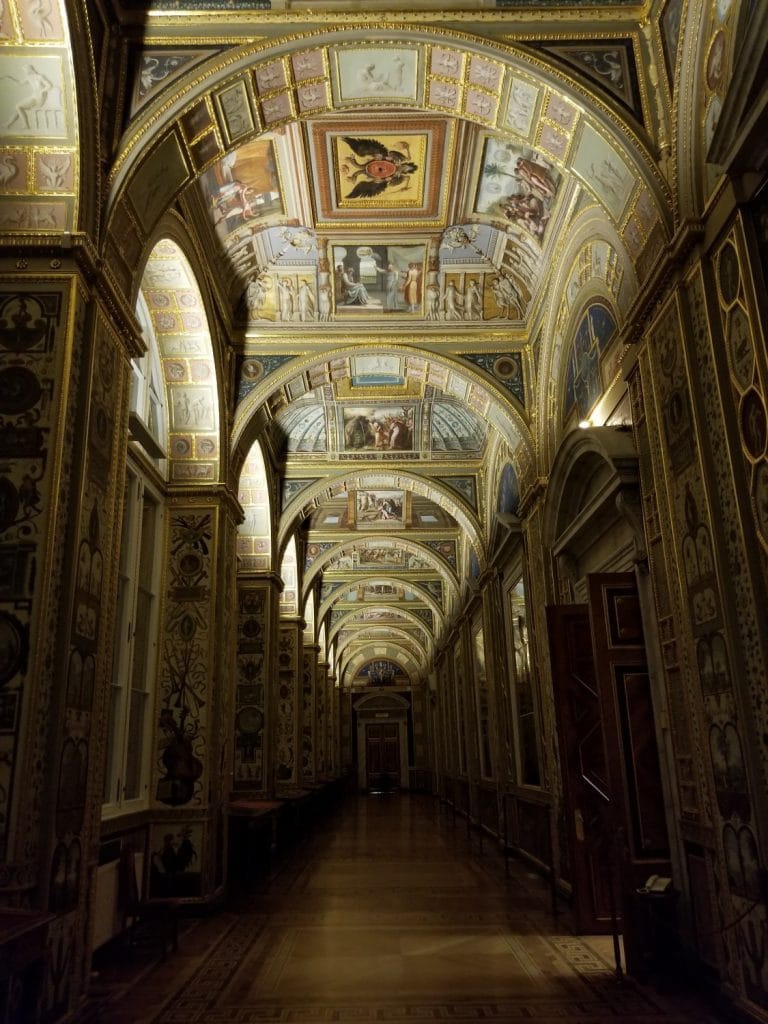
The Hermitage, though, is a unique experience that deserves more than one visit. There is no one specific showstopper that you must visit, but instead numerous significant pieces across walls and halls. Luckily, student admission is free, so you won’t hurt your wallet if you decide to take multiple trips. While on tour, your group will be asked for art and history preferences so that Sergey can help you get the most of your experiences.
If you come during colder months, when you enter, be prepared for heat. During winter, the city is known to turn the radiators on full blast! I recommend wearing layers. Decide how many to remove based on your comfort, and any extra sweaters, jackets, or coats, can be easily turned in at the coat check. Just simply walk up to one of the employees, and they’ll hand you a tag.
Just a quick security check or two later and here you are — surrounded by luxury in the form of gilded walls, red carpets, and numerous sculptures of various shapes and sizes. Even the map may leave you confused about where to start because there are so many choices. Maybe you like that and want to get lost, or maybe you think it better to take a step back and decide on a plan of action. There are certainly enough velvet chairs on which to sit and ponder your next move. Big-name artists you can see here include Leonardo Da Vinci, Michelangelo, and Rembrandt, Van Gogh, Matisse, Monet, and Picasso, to name just a few. There is even a mummy with broken legs and one of the biggest vases in the world.
There are both temporary and permanent exhibitions that you can lose yourself in. While you’re observing the art, the rooms, and the historical pieces, be sure to keep an eye out for the Hermitage cats, as they do exist. The cats were originally brought in as rodent control, and through the years they have remained within the Hermitage’s walls, even though you are quite unlikely to see a rat there today.
An extra bonus if you really enjoy this place is that you can apply to be a volunteer. Just search “Hermitage Volunteer Service” and you can then download the application that can be either emailed or turned in.
The Hermitage has the unique ability to cater to practically any type of art or history lover, so be sure to put it on your list when you’re in the city and make sure to take full advantage of Sergy’s excellent tour when it is offered!
2. by Joe Earnst (2019)
The majesty of beauty of this site can hardly be put into words. No library of books or collection of photographs can ever account for the magnanimous moments of history, the tragic also, the intimate conversations that took place within the halls, and the secrets that are lost for all time to history. For all the photographs I took (about 100), I would say that none can replicate the awe which overtook me.
Do not worry, it is nearly guaranteed that you will visit the Hermitage at the very least once – it is standard on all SRAS programs in St. Petersburg. Plus, with it being located fairly close to campus, before I even left the museum (after being there for nearly 4 hours), I was making plans with my fellow students to return.
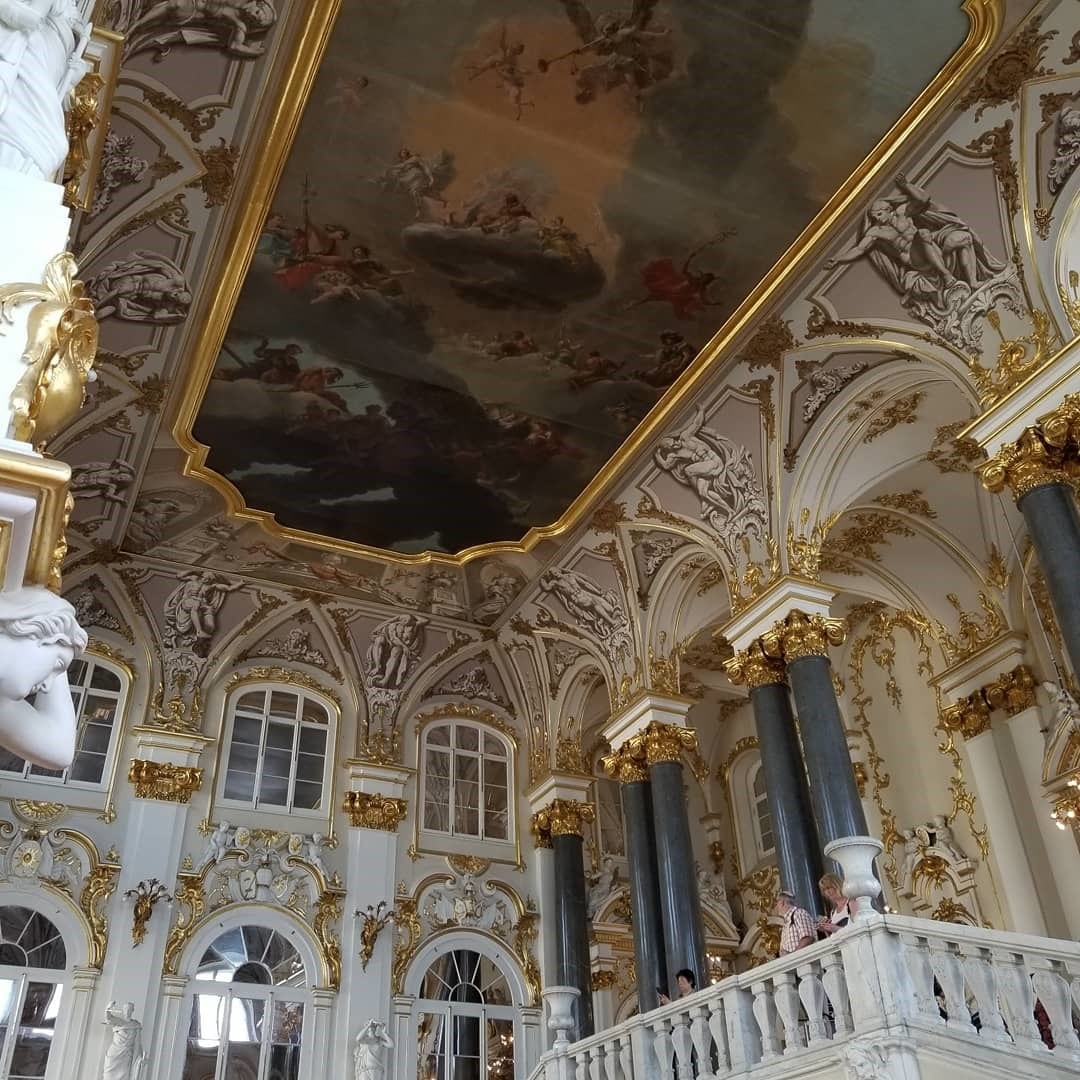
Our small group of 8 was led by an excellent guide arranged by SRAS and our host university – Sasha. We went a specific route weaving back and forth between the Winter Palace and the Museum itself, as Sasha explained the significance of the art and pieces inside the room, as well as what the rooms had been used for in the past. One room stood out to me specifically, the room in which the Provincial Government was arrested by the Bolsheviks. I looked around me and tried to picture what that scene would have looked and sounded like. It really felt like I was in the presence of one of the biggest moments of the last century, and the experience encouraged me to spend some time later in the day researching the storming of the Winter Palace. I had not realized that the Provisional Government had been working out of the Palace, and how the city was not at all prepared for the Revolution.
Although you can purchase audio guides at the site itself, having a well-learned and personal guide really made my tour a step above that which might have been more self-guided. Some students did not come, as SRAS does not make attendance mandatory, but I cannot stress enough the value of being able to ask questions about the history of the site, as well as feel like you are not simply staring at beauty without understanding it.
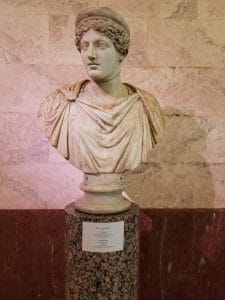
Some things to note, are that you cannot bring in water so make sure you are thoroughly hydrated beforehand. Also, the museum is extensive and inherently requires a lot of walking, warranting comfortable shoes and clothing. You can bring in cameras but note that you cannot use flash at any time.
I have been in St. Petersburg for about 2 weeks now, and I am unsure (though still expecting) something will surpass the experience I had at the Hermitage museum. For some including myself, I think the architecture grasps them the most. I was lucky enough to have two architects as roommates back in Ohio, and therefore was able to at least try to understand the handiwork. For example, how the plumage on top of many columns is of the Egyptian style, or how the symmetry and use of right angles in the throne room invokes Rome, and thus the equivalency to Caesar. Maybe for you, the art or simply the grandeur of it all will keep its hold on you. Maybe it is the thousands-of-years-old Greek pottery, or the medieval icons in the chapel. Whichever your favorite, the Hermitage is beauty and majesty at its finest.
All Articles About the Hermitage on MuseumStudiesAbroad.org
(includes the current article)
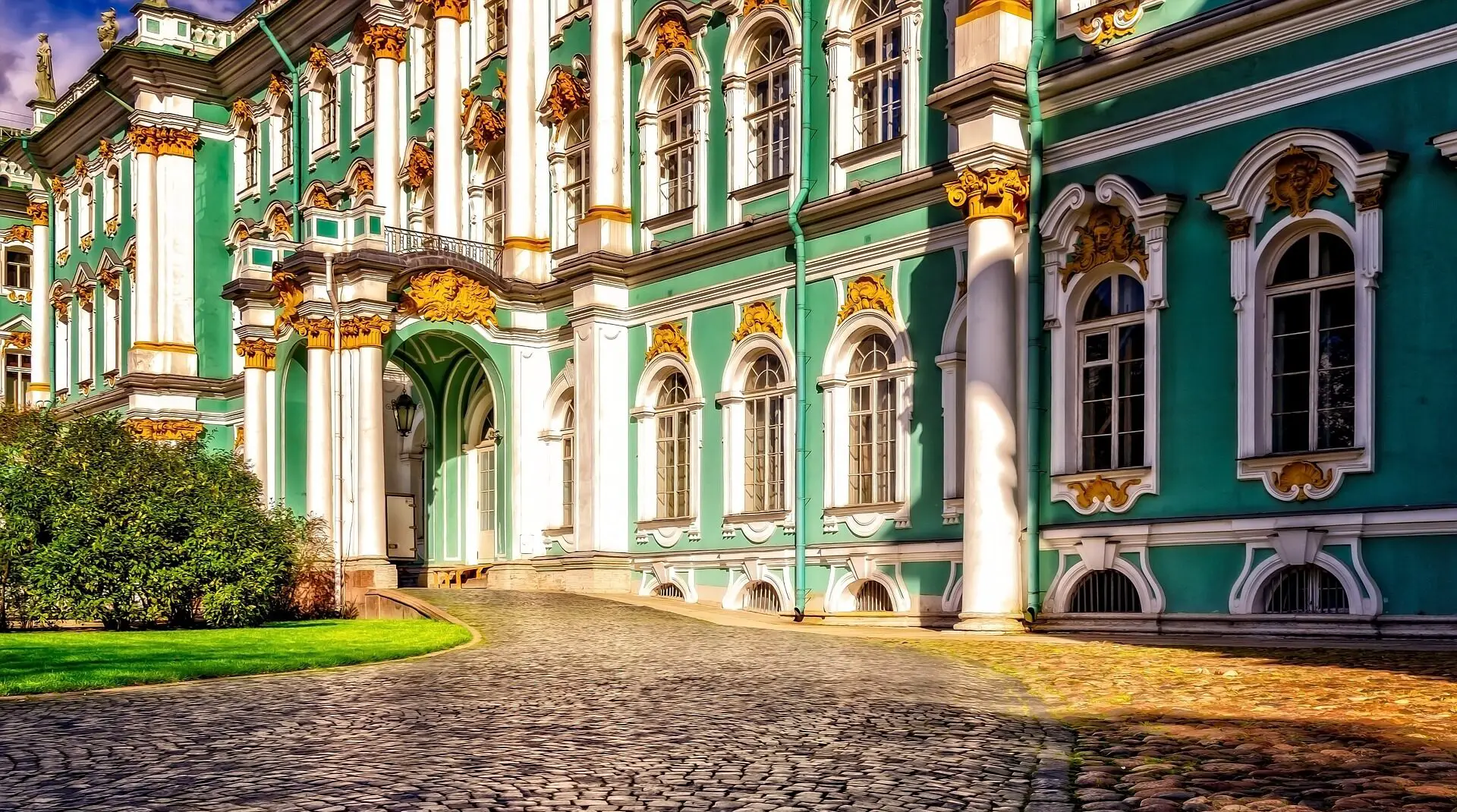
The Hermitage State Museum: Exploring Art and History
The following provides a short history of The Winter Palace building and The State Hermitage Museum as well as details the museum’s current programs and world-wide activities today. It also provides reviews of self exploration and guided tours of the Hermitage. Hermitage tours are included with most St. Petersburg SRAS Programs and Moscow SRAS programs. […]
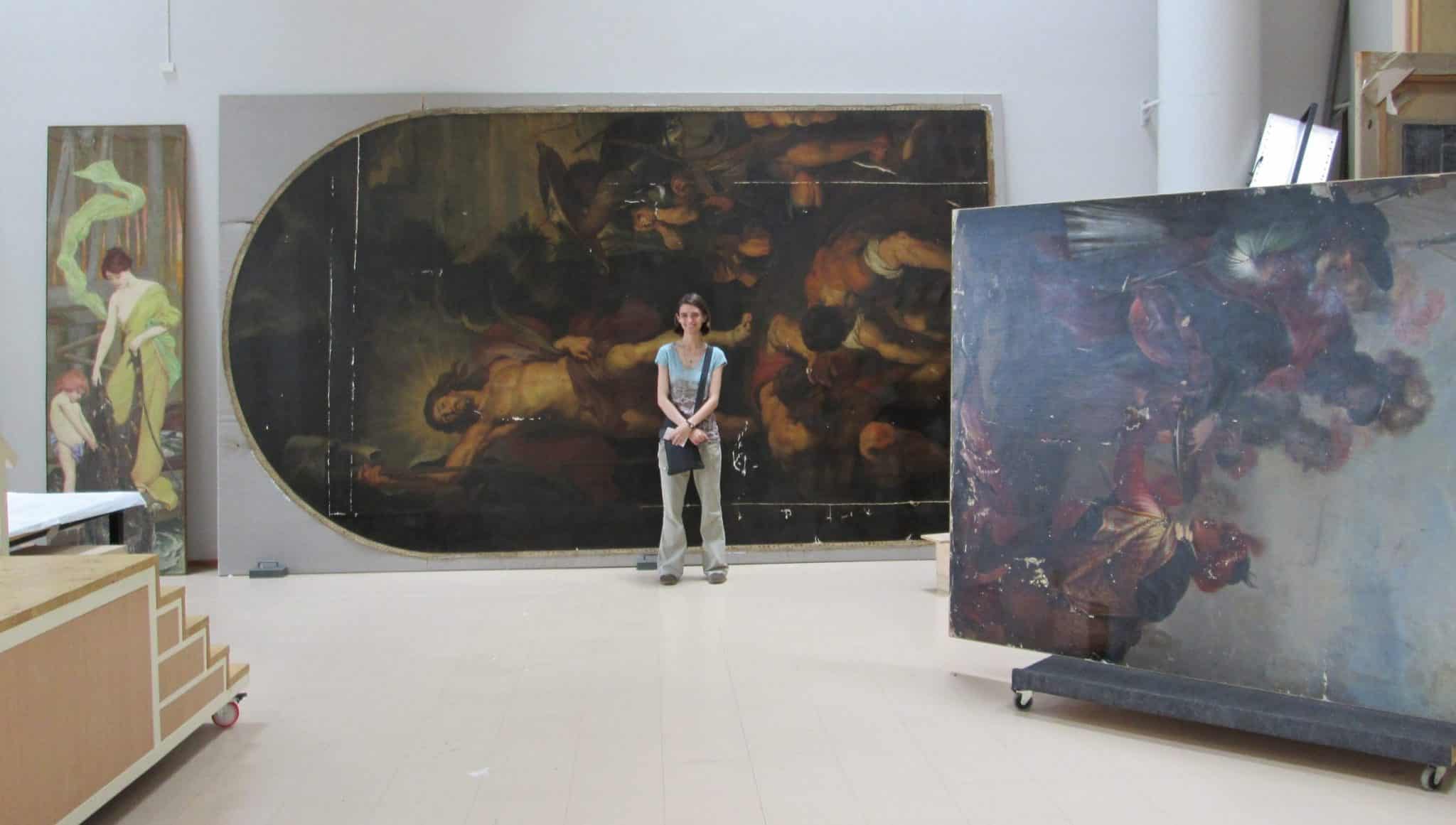
Hermitage Restoration and Storage Centre
Tucked neatly away within Staraya Derevnya just outside the centre of Petersburg sits the Restoration and Storage Centre of the State Hermitage. While it may be only a short metro ride from the bustling Nevsky Prospekt, the Hermitage Storage Building itself is quiet and spacious, entirely free of the crowds that make the main Hermitage […]
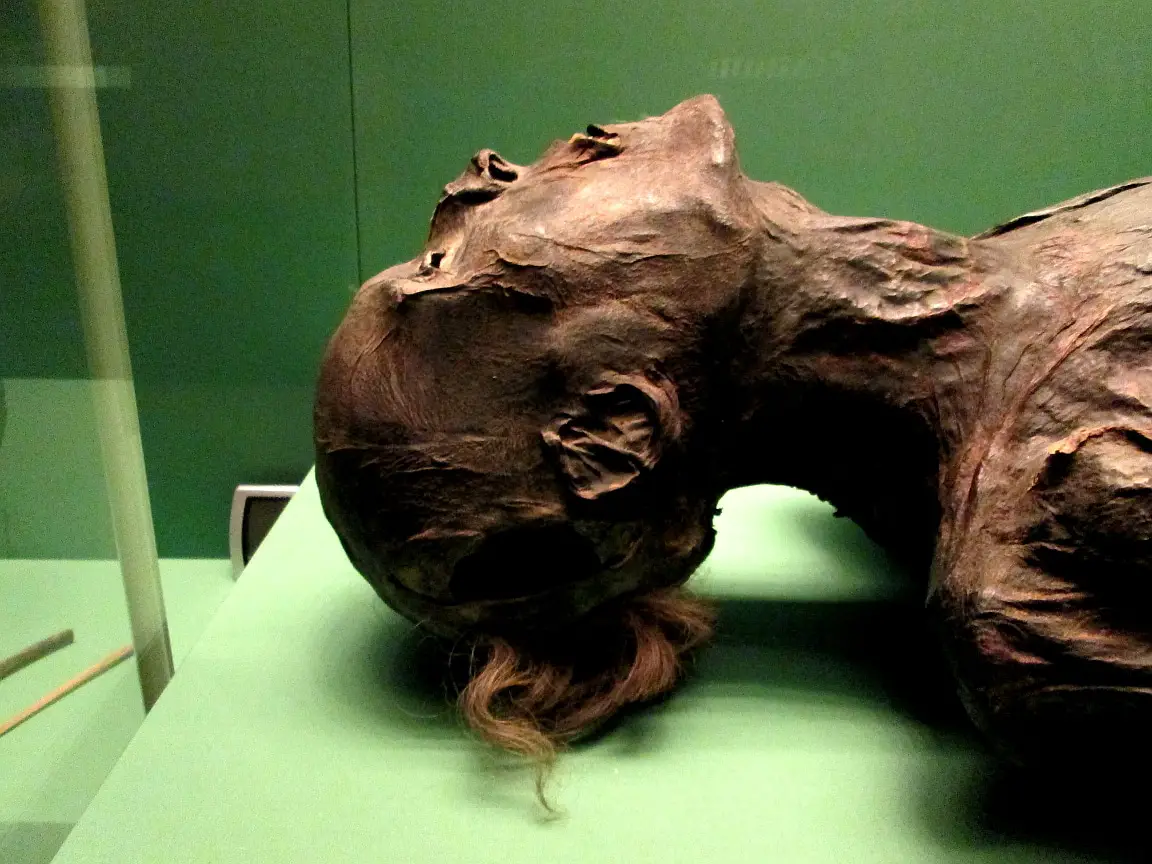
Archaeological Collections and Curation at the Hermitage
Art and Museums in Russia, a program of The School of Russian and Asian Studies, has given me some amazing opportunities in the past two weeks. The official program itself stops at nothing to expose students to as much of St. Petersburg’s art, architecture, and culture as possible. But when I asked program director Elena […]


